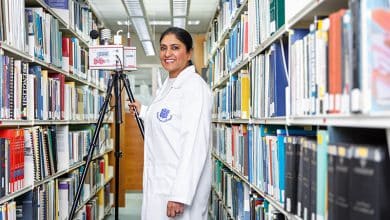KFAS Helps Fund Kuwait University 40th Engineering Design Exhibition

The College of Engineering and Petroleum at Kuwait University held its 40th Engineering Design Exhibition in December 2021, the first time at Sabah Al Salem University City. The exhibition has been running since 2001, with support from the Kuwait Foundation for the Advancement of Sciences (KFAS). Every year, teams of graduate students display their final capstone design projects for feedback and evaluation. The capstone design is the final course engineering students have to pass before graduation, where they put into practice their years of accumulated knowledge to produce unique engineering projects. It also prepares them for real life challenges and expectations of the job market.
In recent years, the exhibition developed from being merely a show to display graduate students’ final projects, to becoming a cornerstone for the development of any engineering project in Kuwait. The highly competitive award with its well-established guidelines pushes students to create unique projects that correspond with urgent local and international problems. Duaij Al Rukaibi, the Director of the Engineering Training and Alumni Centre, believes that the award positively incentivizes students and creates an environment for healthy competition.
“The exhibition is initiating critical conversations on how we can find solutions for problems on a national scale, like developing infrastructure and using natural resources,” he said. “For example, how we can use something like waves to generate energy or solve the issue of asphalt and road surface degradation using advanced engineering technology.”
The exhibition also included digital engineering projects that use Augmented Reality to integrate all kinds of information and present them in a unique, digestible way. “It’s especially attractive for kids,” said Al Rukaibi. “This kind of technology could be very beneficial for the Ministry of Education.”
The exhibition includes seven different themes that engage all engineering departments. This includes: Building and Construction, Clean Energy and Natural Resources, Infrastructure, Technical and Digital Sciences and Communication, Artificial Intelligence and Robotics, Eِngineering Productivity and Mechanization, and Environmental Sustainability.
Any unique and innovative designs get the opportunity to apply for a patent.
“We have many engineering groups who have patents based on their capstone design or research paper.” Al Rukaibi said. “In the Training and Alumni Centre, we walk them through the procedure up until they get their certification. Each year we have up to two or three groups who receive patents.”
By Muneera Al-Yahya




